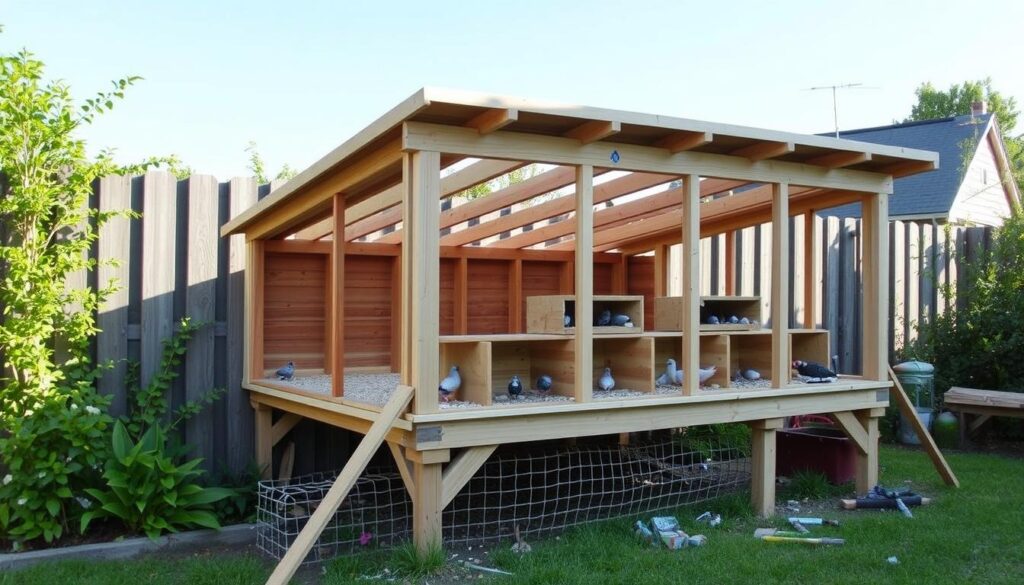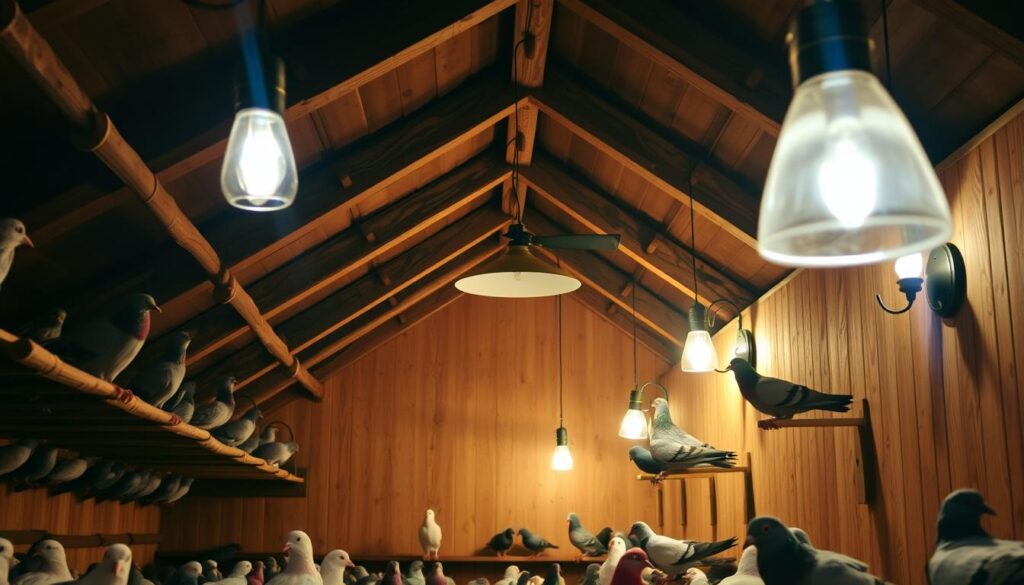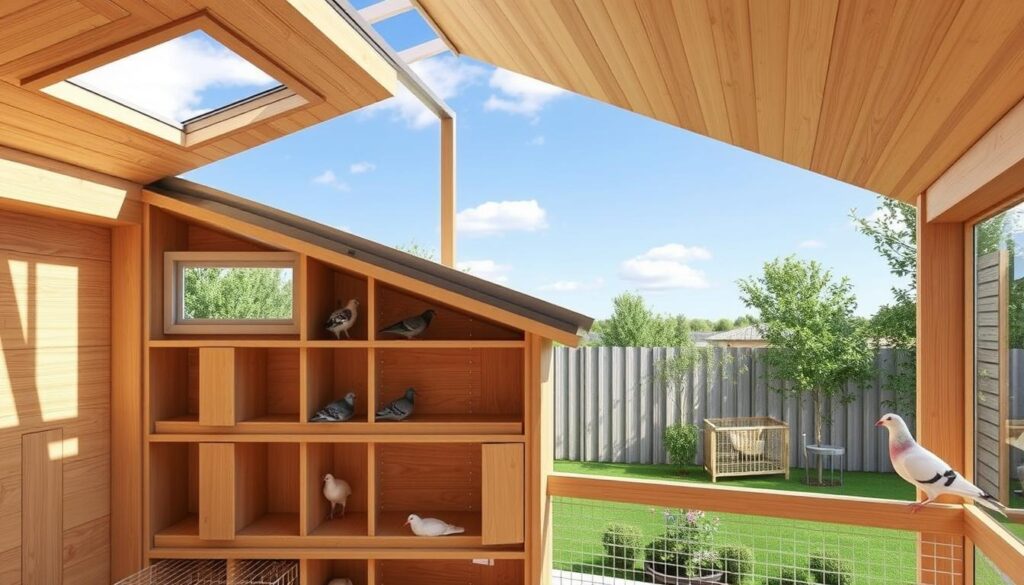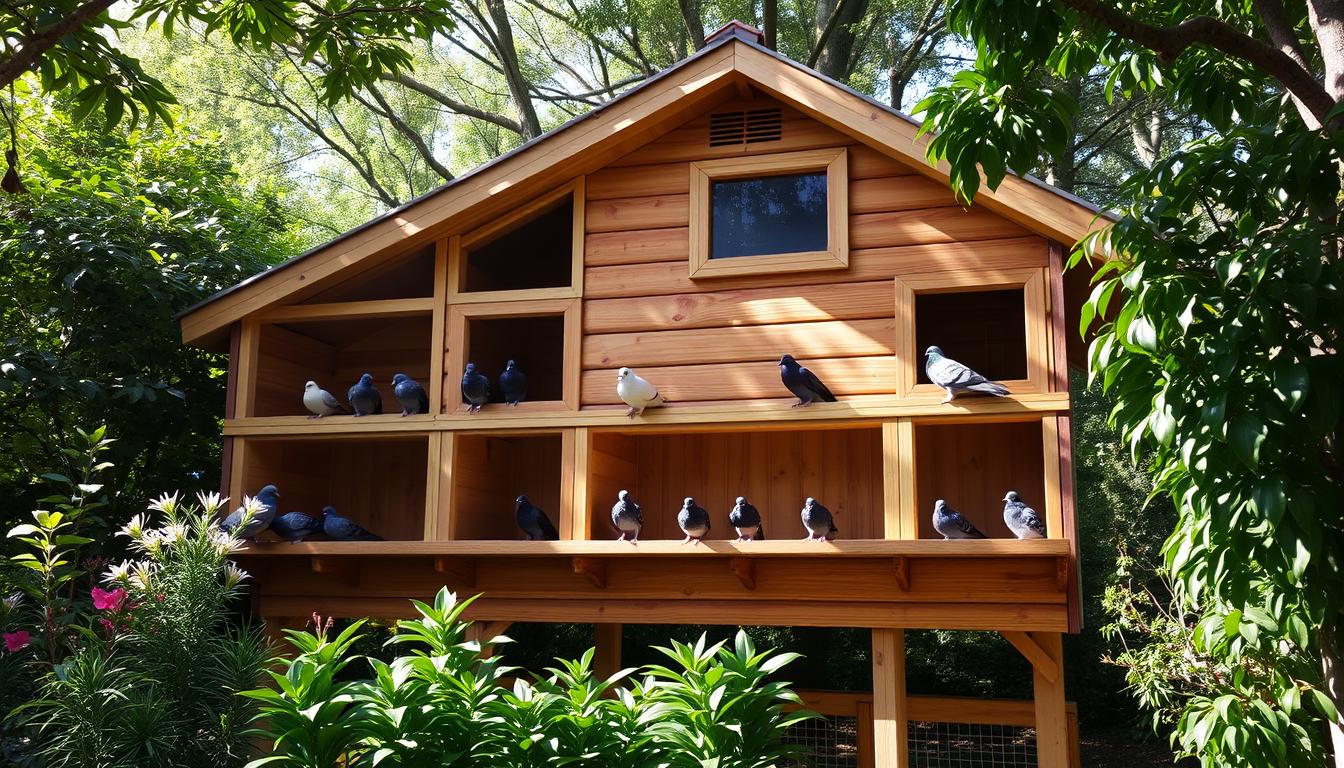Building a pigeon loft needs careful thought to keep your birds happy and healthy. A good coop should have enough room for flying, resting, and nesting. For more info on caring for small birds, check out pigeon house care and design.
A pigeon loft must meet your birds’ needs for safety and comfort. Think about the loft’s size, materials, and features like nesting spots and feeding areas. A well-built loft can greatly improve your pigeons’ health and happiness.
Key Takeaways
- Consider the size and space requirements for your pigeons when designing a pigeon loft.
- A well-designed pigeon coop should include features such as nesting areas and feeding stations.
- The materials used to build the loft should be safe and durable.
- A pigeon house should provide ample space for your pigeons to fly and roost.
- A well-designed pigeon loft can improve the health and happiness of your pigeons.
Essential Features of a Quality Pigeon Loft
Raising pigeons well means having a good loft. It’s important to give them enough space to fly, roost, and nest. Also, a clean and safe place is key. You’ll need the right pigeon supplies to keep them healthy.
A top-notch pigeon loft should have a few important things. These include:
- Adequate ventilation to prevent the buildup of ammonia and moisture
- Proper lighting to regulate the birds’ circadian rhythms
- Insulation to maintain a comfortable temperature
- Predator-proofing to protect your birds from harm
Adding these features to your loft design is crucial. It helps keep your pigeons healthy and happy. Whether you’re experienced or new to raising pigeons
When planning your loft, think about your birds’ needs and the local weather. With the right design and pigeon supplies, you can make a great home for your pigeons.
| Feature | Importance |
|---|---|
| Ventilation | High |
| Lighting | Medium |
| Insulation | High |
| Predator-proofing | High |
Selecting the Ideal Location for Your Coop
Choosing the right spot for your pigeon loft is key for your birds’ health and safety. A good location ensures your pigeons have the best place to live. Think about the climate, weather, and predators when picking a spot for your pigeon coop.
Here are some important things to think about when picking a location:
- Good ventilation to keep your pigeons cool and dry
- Adequate sunlight to promote healthy growth and development
- Protection from the elements, such as wind, rain, and extreme temperatures
- Ease of access for cleaning and maintenance
Considering these factors helps you find the best spot for your pigeon loft. This ensures your birds stay healthy and safe.
Also, think about your pigeon coop‘s design and layout. A well-designed coop makes a comfortable and secure home for your pigeons. It also makes caring for them easier. A great location and a well-designed coop create the perfect home for your pigeons.
Planning Your Pigeon Loft Construction
Building a pigeon house needs careful planning for a safe and healthy space for your birds. Choose the right materials like wood, metal, or plastic. Also, have the tools and equipment you need. Remember to think about your budget, including material and labor costs.
A good start is a material selection guide. This guide should list all the materials you’ll need, such as:
- Lumber for framing
- Wire mesh for ventilation
- Roofing materials for weather protection
- Nesting boxes and perches
Having the right tools is also key for a successful build. You’ll need a hammer, saw, drill, and screwdriver. Don’t forget to include the cost of pigeon supplies like food, water, and bedding in your budget.
To help with budgeting, here’s a table with some estimated costs:
| Material/Supply | Estimated Cost |
|---|---|
| Lumber | $100-$300 |
| Wire mesh | $50-$100 |
| Roofing materials | $200-$500 |
| Pigeon supplies (food, water, bedding) | $50-$100 per month |

By planning well and considering all materials, tools, and supplies, you can build a safe and healthy home for your pigeons.
Foundation and Flooring Requirements
A strong foundation and flooring are key for a pigeon loft. When you build a pigeon coop, make sure the foundation is solid. Also, the flooring should be durable and easy to clean. A concrete slab or a wooden base works well for a sturdy foundation.
Some important things to think about for the foundation and flooring of a pigeon loft include:
- Material durability: The flooring should handle the pigeons’ movements and droppings well.
- Easy cleaning: The flooring should be easy to clean to keep the pigeons healthy.
- Drainage: The flooring should let water drain properly to avoid disease.
By thinking about these points and picking the right materials, you can create a pigeon coop with a strong foundation and flooring. This will give your pigeons a safe and healthy place to live.
Always put your pigeons’ health first when designing and building their pigeon loft.
| Foundation Type | Advantages | Disadvantages |
|---|---|---|
| Concrete Slab | Durable, easy to clean | Expensive, heavy |
| Wooden Base | Affordable, easy to install | Less durable, prone to rot |
Proper Ventilation Systems for Healthy Birds
Keeping your pigeon loft healthy requires good ventilation. You need airflow, the right hardware, and to adjust with the seasons. A well-ventilated coop is key to stop respiratory issues and keep your birds happy.
A good system brings in fresh air and takes out stale and moist air. Use windows, vents, and fans for this. Make sure to get a top-notch ventilation system that you can adjust with the seasons.
Air Flow Patterns
Air flow is very important for your pigeons’ health. A good system should keep air flowing well, without drafts or cold spots.
Ventilation Hardware Options
There are many options for ventilation hardware. Look for durable, easy to maintain, and energy-saving ones.
Seasonal Adjustments
Adjusting your ventilation with the seasons is crucial. In summer, you might need more air to avoid heat. In winter, less air helps keep the heat in.
| Season | Ventilation Adjustment |
|---|---|
| Summer | Increase ventilation to prevent overheating |
| Winter | Reduce ventilation to conserve heat |
Installing Effective Lighting Solutions
Lighting is key for a comfy and healthy space for your pigeons in a pigeon loft or pigeon house. Think about natural and artificial light, and when to use them. A good lighting plan helps your pigeons stay healthy and productive.
It’s important to mix natural and artificial light well. Natural light should be the main source during the day. Artificial light helps when it’s dark or at night. Here are some tips for artificial lighting:
- Color temperature: Warm or cool white lights can change how your pigeons act and feel.
- Intensity: Keep the light soft and not too bright to avoid stress.
- Duration: Stick to a light schedule that matches day and night.
With the right lighting, your pigeons will love their pigeon loft or pigeon house. This can make them better at breeding, racing, and more.

A good lighting system is vital for your pigeons’ health and happiness. By understanding their needs, you can make a pigeon loft or pigeon house that supports their well-being.
Designing the Perfect Nesting Areas
Creating a good nesting area is key for breeding healthy pigeons. A pigeon breeding loft needs nest boxes that fit the birds’ needs. The breeding area should be well-ventilated and safe for the pigeons’ health.
Nest Box Specifications
Nest boxes should offer a cozy and safe spot for pigeons to lay eggs and raise their young. They should be made of strong materials, easy to clean, and well-ventilated. The size of the boxes depends on the pigeon breed and size, but aim for at least 12 inches per bird.
When designing nest boxes for a pigeon racing loft, consider these features:
- Easy access for cleaning and maintenance
- Good ventilation to prevent ammonia and moisture buildup
- A secure and comfortable space for the pigeons to nest
Breeding Section Layout
The breeding section of the loft should be safe and healthy for pigeons. It needs enough space, ventilation, and light. The layout depends on the pigeons’ needs and the breeder’s goals.
Water and Feeding Station Setup
Proper pigeon care starts with a well-designed water and feeding station. This is key for keeping your birds healthy. A good station should have the right feeder types and placement for your birds. The water system must be safe and easy to clean.
Choosing the right feeder types and where to place them is important. You can pick from tray feeders, hopper feeders, and tube feeders. Where you put these feeders matters a lot. They should prevent waste and make cleaning and refilling easy.
Feeder Types and Placement
- Tray feeders: ideal for small lofts and easy to clean
- Hopper feeders: suitable for larger lofts and can hold more feed
- Tube feeders: great for preventing waste and spillage
The design of your water system is also crucial. It should be safe, easy to clean, and always provide fresh water. Using pigeon supplies like water bottles or automatic systems ensures your birds always have fresh water.
Advanced Racing Pigeon Loft Features
For serious pigeon breeders and racers, a well-designed pigeon racing loft is key to success. Features like specialized nesting boxes, breeding sections, and training equipment can help you stand out. A pigeon breeding loft with a smart layout boosts your birds’ health and productivity.
When designing your pigeon racing loft, consider these important features:
- Ample space for birds to fly and exercise
- Adequate ventilation and lighting
- Easy access for cleaning and maintenance
- Secure storage for equipment and supplies
A well-designed pigeon breeding loft should also have:
- Separate breeding and nesting areas
- Easy-to-clean feeding and watering systems
- Ample space for birds to roost and rest

By adding these advanced features to your pigeon racing loft or pigeon breeding loft, you create a healthy space for your birds. This boosts your chances of success in pigeon racing.
| Feature | Description |
|---|---|
| Specialized Nesting Boxes | Designed to provide a safe and comfortable space for birds to nest and raise their young |
| Breeding Sections | Separate areas for breeding birds, designed to promote healthy reproduction and minimize stress |
| Training Equipment | Equipment such as toss crates and training baskets, designed to help birds develop the skills they need to compete |
Security Measures and Predator Protection
Protecting your pigeons is key, and a secure pigeon loft is crucial. A well-designed coop can keep predators out. It’s important to think about hardware needs, entry protection, and monitoring systems.
A secure loft needs strong locks and latches to keep predators away. Locks should be tough and simple to use. Also, latches must be secure and weather-resistant.
Hardware Requirements
- Sturdy locks and latches
- Durable materials for construction
- Easy-to-use locking mechanisms
Entry points like doors and windows must be strong and locked well. A coop with secure entry points keeps predators out.
Monitoring Systems
Cameras and alarms can spot threats to your pigeons. These systems add security inside and outside the loft.
With these security steps, you can protect your pigeons from harm. This makes a safe place for them to live in your loft or coop.
Cleaning and Maintenance Access Points
Proper pigeon care means keeping the coop clean and well-maintained. It’s key to have easy access for cleaning and upkeep. This includes doors, windows, and panels that can be taken out.
When building your coop, think about these features for easy cleaning and upkeep:
- Easy-to-clean surfaces and materials
- Accessible nesting areas and perches
- Adequate ventilation to reduce moisture and odors
Having the right pigeon supplies also helps. You’ll need cleaning products, disinfectants, and tools like scrub brushes and hoses.
With these features and supplies, you can keep your coop clean and safe. This ensures a healthy home for your pigeons.
| Feature | Importance | Benefits |
|---|---|---|
| Easy-to-clean surfaces | High | Reduces cleaning time and effort |
| Accessible nesting areas | Medium | Improves pigeon health and productivity |
| Adequate ventilation | High | Reduces moisture and odors, improving pigeon health |
Storage Solutions for Equipment and Supplies
Keeping a pigeon loft clean and organized is key. A good pigeon house should have spots for feed, medical supplies, and tools. This keeps the loft tidy, lowers disease risk, and reduces bird stress.
Feed storage areas should be simple to get to and clean. Use bins or containers with tight lids to keep out moisture and pests. Store feed in a cool, dry spot to keep it fresh.
Feed Storage Areas
Here are some tips for feed storage:
- Make sure it’s easy to clean and refill.
- Use containers that seal tight to keep out moisture and pests.
- Store feed in a cool, dry place to keep it fresh.
Medical Supply Organization
Having a good system for medical supplies is crucial. Designate a spot for them, like a cabinet or shelf. Keep things like bandages, wipes, and meds handy.
With these storage solutions, your pigeon loft will be clean and healthy. A well-organized pigeon house helps your birds stay happy and healthy. This makes pigeon-keeping more rewarding.
Follow these tips to create a great storage system for your pigeon loft. It will help keep your birds healthy and happy.
Future-Proofing Your Pigeon Paradise
Building your dream pigeon loft means thinking about the future. Design a loft that can grow with you and your pigeons. Look at how it can expand, get new tech, and stay easy to clean.
Make your loft flexible for adding more space or changing things around. Use strong, lasting materials to protect it from weather and time. Add smart tech like auto feeders to make caring for your pigeons easier.
By planning ahead, you’ll make a great home for your pigeons. This will help your pigeon breeding or racing program succeed for many years.
FAQ
What are the basic space requirements for a quality pigeon loft?
A quality pigeon loft needs enough space for your birds to fly, roost, and nest. The size depends on how many birds you have. A good rule is to give each bird 2-3 square feet of space.
What are the critical design elements of a pigeon loft?
Key design elements include ventilation, lighting, and insulation. Good airflow and temperature control keep your birds healthy. Proper lighting helps with breeding and nesting.
What safety considerations should be taken into account when building a pigeon loft?
When building a pigeon loft, think about keeping predators out and preventing escape. The loft should be safe and secure for your birds.
How do I select the ideal location for my pigeon coop?
Choose a location based on climate, weather, and predator risks. It should have good ventilation, sunlight, and protection from the elements. Easy access for cleaning is also important.
What materials should I use for my pigeon loft construction?
The materials depend on your budget and preferences. Wood, metal, and plastic are common choices. Pick durable, easy-to-clean materials for a safe environment.
What tools do I need for pigeon loft construction?
The tools needed vary based on your design and materials. You’ll likely need power saws, drills, hammers, and measuring tools. Having the right tools is crucial for a successful build.
How do I budget for my pigeon loft construction?
When budgeting, consider material costs, labor, and permits. Don’t forget ongoing expenses like feed, bedding, and vet care.
What are the foundation and flooring requirements for a pigeon loft?
A strong foundation and durable flooring are essential. Use a concrete slab or sturdy wooden base for the foundation. Choose easy-to-clean flooring like concrete or vinyl.
How do I ensure proper ventilation in my pigeon loft?
Proper ventilation is key for your birds’ health. Consider airflow, install the right hardware, and adjust for seasons to control temperature and humidity.
What lighting solutions should I use in my pigeon loft?
Effective lighting is important. Use a mix of natural and artificial light. Set up lighting schedules to keep your birds comfortable and healthy.
How do I design the perfect nesting areas in my pigeon loft?
Designing great nesting areas is crucial. Ensure nest boxes meet your birds’ needs and have a safe, well-ventilated breeding section.
How should I set up the water and feeding stations in my pigeon loft?
A good water and feeding system is vital. Choose the right feeders and place them well. Make sure your water system is safe and easy to clean.
What advanced features should I consider for a racing pigeon loft?
For serious breeders or racers, consider special nesting boxes, breeding sections, and training gear. These features can help your program succeed.
How do I ensure security and predator protection in my pigeon loft?
Security and predator protection are crucial. Install locks, protect entry points, and use monitoring systems to detect threats.
How do I design my pigeon loft for easy cleaning and maintenance?
Design your loft for easy cleaning and maintenance. Include access points like doors, windows, and removable panels to make upkeep simple.
How should I organize the storage solutions in my pigeon loft?
Proper storage keeps your loft organized. Use designated areas for feed and medical supplies. This ensures everything is accessible and well-maintained.
How can I future-proof my pigeon loft?
Future-proofing your loft is vital for your birds’ long-term health. Consider expansion, upgrades, and maintenance to ensure a sustainable program.

